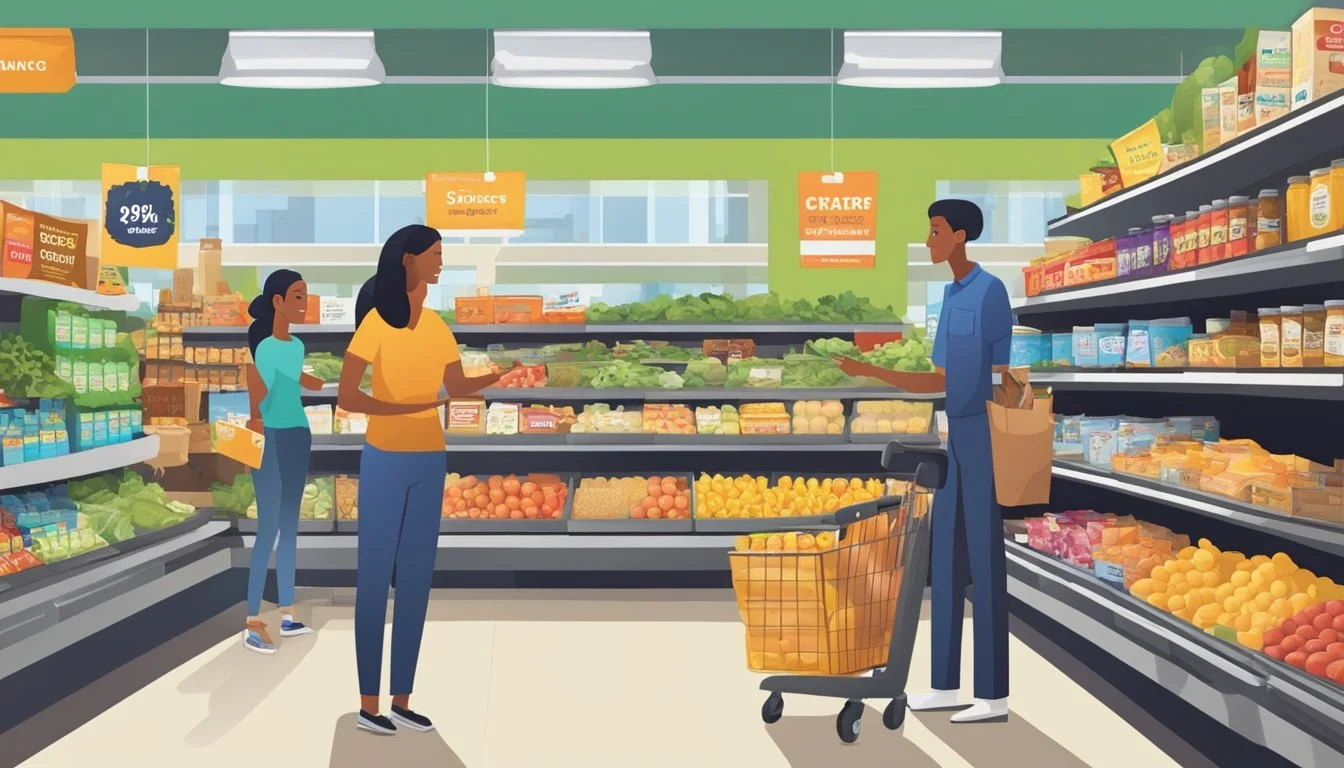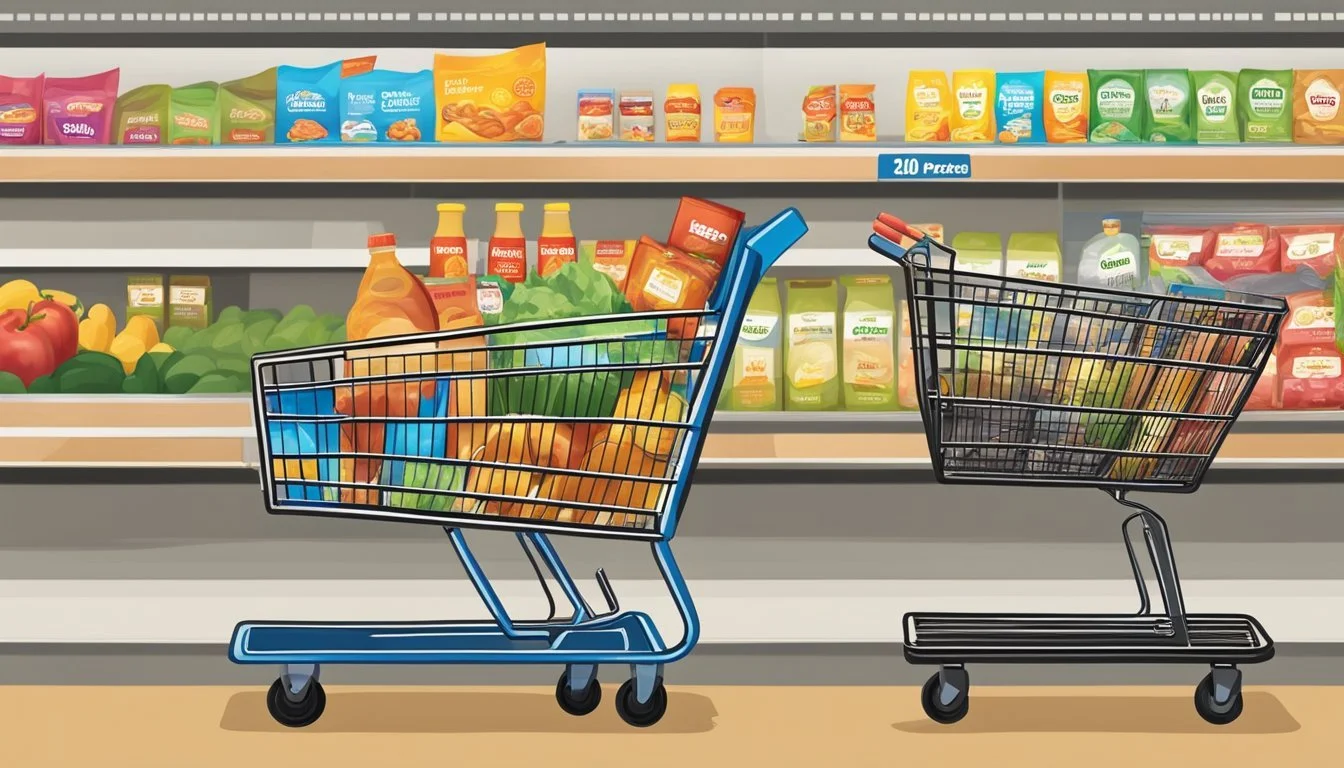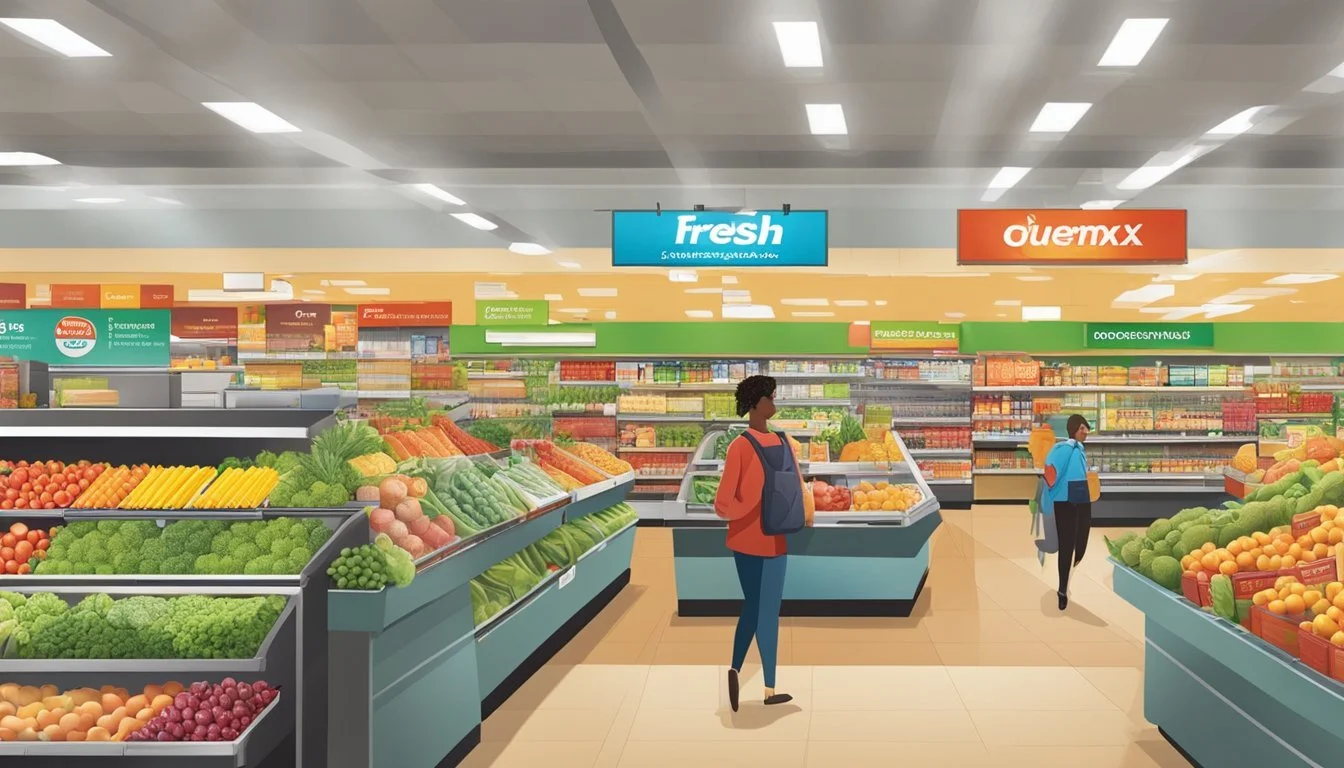FoodMaxx vs Grocery Outlet
A Comprehensive Comparison of Budget Chains
FoodMaxx and Grocery Outlet are two popular discount grocery chains that offer budget-friendly options for shoppers. Both stores aim to provide low prices on a variety of grocery items, but they have different approaches to achieving this goal. Based on a comparison of prices for a basket of common grocery items, FoodMaxx was found to be approximately 3% cheaper than Grocery Outlet.
While price is a significant factor for many shoppers, it's not the only consideration when choosing between these two supermarkets. Grocery Outlet is known for its ever-changing inventory of discounted name-brand products, which can lead to exciting finds but may lack consistency in product availability. FoodMaxx, on the other hand, tends to offer a more stable selection of items, which some customers may prefer for their regular shopping needs.
The choice between FoodMaxx and Grocery Outlet ultimately depends on individual shopping preferences and priorities. Those who enjoy the thrill of discovering new deals and don't mind a constantly changing product lineup might lean towards Grocery Outlet. Shoppers who value consistency and slightly lower overall prices may find FoodMaxx more appealing. Both stores have carved out their niches in the competitive grocery market, providing valuable options for budget-conscious consumers.
Company Overviews
FoodMaxx and Grocery Outlet are two distinct grocery chains with unique histories and market approaches. Both stores aim to provide affordable groceries but employ different strategies to achieve this goal.
History of FoodMaxx
FoodMaxx is a warehouse-style grocery store chain owned by The Save Mart Companies. It was established in 1986 as a discount grocery concept. FoodMaxx stores primarily operate in Northern California and Northern Nevada.
The chain focuses on a no-frills shopping experience to keep prices low. FoodMaxx stores typically have a warehouse-like atmosphere with minimal decor and basic shelving.
Customers often bag their own groceries at FoodMaxx to reduce labor costs. This cost-saving measure allows the company to offer lower prices on a wide range of products.
History of Grocery Outlet
Grocery Outlet traces its roots back to 1946 when Jim Read founded the company as Cannery Sales in San Francisco. The business initially focused on selling surplus and discounted canned goods.
In the 1970s, Grocery Outlet began expanding through independently operated franchise locations. This model allowed for rapid growth while maintaining local ownership in each community.
The company expanded to the East Coast in 2011, marking a significant milestone in its growth. Grocery Outlet stores are known for their "treasure hunt" shopping experience, offering changing inventory of discounted brand-name products.
Market Position and Target Demographic
FoodMaxx targets budget-conscious shoppers looking for everyday low prices on groceries. Its warehouse format appeals to customers willing to sacrifice ambiance for savings.
The chain competes directly with other discount grocers and traditional supermarkets in its operating areas. FoodMaxx stores often locate in working-class neighborhoods and areas with cost-sensitive consumers.
Grocery Outlet positions itself as a "extreme value" retailer, offering brand-name products at significant discounts. The company attracts bargain hunters and deal-seekers across various income levels.
Its ever-changing inventory creates a sense of excitement for shoppers. Grocery Outlet stores can be found in diverse locations, from urban centers to smaller towns.
Price Comparison
FoodMaxx and Grocery Outlet both offer competitive pricing, but their strategies and outcomes differ. A closer look at their everyday pricing, savings programs, and specific product costs reveals key distinctions between these budget-friendly grocery chains.
Everyday Pricing Strategies
FoodMaxx employs a no-frills approach to keep prices low. The store focuses on basic presentation and minimal services to reduce overhead costs. This allows them to offer consistently low prices across most product categories.
Grocery Outlet, on the other hand, uses an opportunistic buying model. They purchase surplus inventory and discontinued items from manufacturers at steep discounts. This results in a constantly changing inventory with significant savings on brand-name products.
Both stores typically offer lower prices than traditional supermarkets like Safeway or Target. However, their prices can vary significantly depending on the specific items and timing of purchases.
Discounts and Savings Programs
FoodMaxx provides weekly ad specials and digital coupons through their mobile app. Customers can load offers directly to their loyalty card for easy redemption at checkout.
Grocery Outlet offers a simpler approach to savings. They don't have a loyalty program or digital coupons. Instead, they rely on their everyday low prices and in-store specials.
Neither store matches the extensive loyalty programs of larger chains like Safeway or Walmart. However, their base prices are often low enough that additional discounts aren't necessary for budget-conscious shoppers.
Case Study: Common Grocery Items
A comparison of common grocery items reveals the pricing differences between FoodMaxx and Grocery Outlet:
Item FoodMaxx Grocery Outlet Milk (1 gallon) $3.29 $3.49 Eggs (1 dozen) $2.99 $2.79 Bread (1 loaf) $1.99 $2.29 Bananas (per lb) $0.59 $0.69
FoodMaxx tends to have lower prices on staple items and produce. Grocery Outlet often beats FoodMaxx on packaged goods and brand-name products.
Overall, FoodMaxx's total came to $104.55 for a typical grocery trip, while Grocery Outlet's total was $107.63. This represents a 3% difference in favor of FoodMaxx.
Product Selection
FoodMaxx and Grocery Outlet offer distinct product selections to cater to different customer needs. Both stores provide a mix of brand names, private labels, and specialty items.
Private Labels vs. Brand Names
FoodMaxx stocks a wide range of generic staples under its private label. These products offer budget-friendly options for everyday essentials. Grocery Outlet, on the other hand, specializes in discounted brand-name products.
Grocery Outlet often features overstock or closeout items from well-known brands. This allows customers to purchase familiar products at reduced prices.
FoodMaxx maintains a consistent inventory of private label goods. Grocery Outlet's selection can vary significantly from week to week due to its business model.
Organic and Health-Focused Offerings
Both stores have expanded their organic and health-focused product lines in recent years. FoodMaxx typically offers a steady selection of organic produce and meats.
Grocery Outlet's organic offerings can be more unpredictable. They often have deals on organic items, but availability may fluctuate.
FoodMaxx tends to have a more extensive selection of fresh organic produce. Grocery Outlet sometimes features specialty organic products at discounted rates.
Both stores stock health-focused items like gluten-free and vegan options. The selection may be more limited compared to traditional supermarkets.
Prepared Foods and Convenience Options
FoodMaxx provides a range of prepared foods and convenience options. Their deli section offers hot meals, sandwiches, and salads for quick meal solutions.
Grocery Outlet's prepared food selection is generally more limited. They focus primarily on packaged convenience foods rather than freshly prepared items.
FoodMaxx typically has a larger selection of frozen meals and heat-and-eat options. Grocery Outlet may offer unique or gourmet frozen items at discounted prices.
Both stores stock a variety of snacks and beverages for on-the-go consumers. FoodMaxx tends to have a more consistent selection in this category.
Quality Assessment
Product quality plays a crucial role in the grocery shopping experience. Both FoodMaxx and Grocery Outlet offer competitive prices, but their quality standards differ in key areas.
Freshness of Produce
FoodMaxx maintains a consistent supply of fresh fruits and vegetables. Their produce section features a wide variety of seasonal items. Many FoodMaxx stores receive daily deliveries to ensure optimal freshness.
Grocery Outlet's produce quality can vary. As an overstock retailer, their selection changes frequently. Some items may be close to expiration, offering significant discounts. Shoppers often find unique or exotic produce options at Grocery Outlet.
Both stores implement regular quality checks. FoodMaxx tends to have a more reliable produce selection, while Grocery Outlet offers more diverse options at lower prices.
Meat Standards and Varieties
FoodMaxx offers a standard range of meat options. Their selection includes common cuts of beef, pork, and poultry. The meat quality is generally consistent, meeting industry standards for freshness and safety.
Grocery Outlet's meat department can be hit-or-miss. They often carry premium brands at discounted prices. Shoppers may find high-quality cuts alongside more budget-friendly options.
Both stores sell bacon and eggs. FoodMaxx typically offers these items at competitive prices with consistent quality. Grocery Outlet may have varying brands and qualities depending on their current stock.
Bakery and Deli Offerings
FoodMaxx provides a modest bakery and deli section. Their offerings include freshly baked bread, cakes, and basic deli meats and cheeses. The quality is generally reliable, catering to everyday needs.
Grocery Outlet's bakery and deli selections can be more eclectic. They often carry specialty items and gourmet products at discounted prices. The availability of these items may be inconsistent due to their overstock business model.
Both stores offer pre-packaged deli meats and cheeses. FoodMaxx maintains a steady selection, while Grocery Outlet may feature premium brands at lower prices when available.
Customer Experience
FoodMaxx and Grocery Outlet offer distinct shopping experiences that cater to different customer preferences. Both stores have loyal followings, but their approaches to service and store design vary significantly.
Store Layout and Navigation
FoodMaxx typically features a warehouse-style layout with wide aisles and bulk displays. Products are often stacked on pallets or in large bins, emphasizing the no-frills approach. This setup can make finding specific items easier for shoppers familiar with the store.
Grocery Outlet, on the other hand, has a more traditional supermarket layout. Aisles are narrower, and product placement can be less predictable due to the constantly changing inventory. This can create a treasure hunt atmosphere, appealing to customers who enjoy discovering new items.
Both stores use clear signage, but Grocery Outlet's ever-changing stock may require more exploration from shoppers.
Staff Service and Knowledge
FoodMaxx generally operates with a lean staff model. Employees focus on keeping shelves stocked and lines moving efficiently. Customer service is available but may be less personalized compared to traditional supermarkets.
Grocery Outlet stores are often independently owned and operated. This can lead to more engaged staff who are knowledgeable about current deals and product offerings. Employees may be more readily available to assist customers with questions or locate items.
Some Grocery Outlet locations have been praised for their friendly, community-oriented service. This personal touch can be a significant factor for customers choosing between the two stores.
Checkout Efficiency
FoodMaxx prioritizes quick transactions with multiple checkout lanes and self-service options. The focus is on getting customers through the line as quickly as possible, which can be beneficial for shoppers on tight schedules.
Grocery Outlet's checkout process can vary by location. Some stores have embraced modern technology with self-checkout options, while others maintain a more traditional approach. Lines may move slower during peak hours due to the bargain-hunting nature of many shoppers.
Both stores typically require customers to bag their own groceries, which can impact checkout speed. FoodMaxx often provides boxes for free, while Grocery Outlet may charge for bags or encourage customers to bring their own.
Savings and Budget Comparison
FoodMaxx and Grocery Outlet offer distinct approaches to helping shoppers save money. Their strategies range from membership programs to bulk buying options, each tailored to different customer needs.
Membership Fees and Warehouse Clubs
FoodMaxx operates as a traditional grocery store without membership fees. This allows shoppers to access savings without upfront costs.
Grocery Outlet, while also free to shop at, partners with third-party delivery services that may require subscriptions. Some customers use Amazon Prime for deliveries, adding an indirect membership cost.
Warehouse clubs like Costco charge annual fees but offer bulk savings. For families, these fees can be offset by the discounts on large quantities.
Promotions and Loss Leaders
FoodMaxx regularly features loss leaders - items priced below cost to attract customers. These often include staples like milk, bread, and produce.
Grocery Outlet specializes in closeouts and overstock items. This results in ever-changing inventory with deep discounts on brand-name products.
Both stores use weekly ads to highlight deals. FoodMaxx tends to have more consistent promotions, while Grocery Outlet's offerings vary widely week to week.
Family and Bulk Buying
FoodMaxx caters to families with larger pack sizes and multi-buy discounts. Their store layouts make it easy to find family-sized options.
Grocery Outlet's inventory fluctuates, sometimes featuring bulk items at steep discounts. This can benefit families willing to stock up when deals appear.
Both stores offer savings on bulk purchases, but FoodMaxx provides more reliable availability of family-sized products. Grocery Outlet's bulk deals are less predictable but can offer significant savings when available.
Convenience Services
FoodMaxx and Grocery Outlet offer various convenience services to enhance the shopping experience. These services aim to save time and provide flexibility for customers with busy schedules.
Grocery Delivery Options
FoodMaxx partners with Instacart to provide grocery delivery services. Customers can order groceries online and have them delivered to their doorstep within hours. This service is available in most areas where FoodMaxx operates.
Grocery Outlet also offers delivery through Instacart in select locations. However, their delivery service is not as widely available as FoodMaxx's.
Both stores charge delivery fees, which vary based on order size and delivery time. Instacart Express membership provides free delivery on orders over $35 for both retailers.
Online Shopping and In-Store Pickup
FoodMaxx provides an online shopping platform where customers can browse products, create shopping lists, and place orders for in-store pickup. This service allows shoppers to save time by avoiding in-store browsing.
Grocery Outlet does not currently offer online shopping or in-store pickup services. Customers must shop in-person at their physical locations.
FoodMaxx's online platform also features digital coupons and personalized deals, which can be applied to pickup orders. This integration of online and in-store shopping provides added convenience and potential savings for customers.
Demographic and Geographic Reach
FoodMaxx and Grocery Outlet cater to distinct customer bases through their store locations and expansion strategies. Their presence in urban and rural areas, as well as their accessibility, shapes their market positioning and customer demographics.
Urban vs. Rural Store Presence
FoodMaxx predominantly operates in urban and suburban areas, targeting densely populated regions. The chain focuses on serving diverse communities in cities and their outskirts. Grocery Outlet, on the other hand, maintains a more balanced presence across urban, suburban, and rural locations. This broader geographic spread allows Grocery Outlet to reach a wider range of customers, including those in smaller towns and less populated areas.
FoodMaxx stores are typically larger, offering a wider inventory to meet the needs of urban shoppers. Grocery Outlet opts for smaller footprints, adapting to both city centers and rural main streets. This flexibility in store size enables Grocery Outlet to fit into various retail spaces and serve different community sizes effectively.
Expansion and Accessibility
Grocery Outlet has pursued an aggressive expansion strategy, opening new stores across multiple states, including California. This approach has increased the chain's accessibility to a growing customer base. FoodMaxx, part of The Save Mart Companies, has focused its expansion efforts primarily within California, strengthening its regional presence.
Accessibility differs between the two chains. FoodMaxx stores are often located in shopping centers or standalone buildings with ample parking, catering to car-dependent shoppers. Grocery Outlet's smaller stores can be found in more walkable areas, making them accessible to pedestrians and public transit users.
A market basket survey comparing the two stores revealed that Grocery Outlet's prices were 22% lower than the average, while FoodMaxx came in at 21% lower. This pricing strategy attracts budget-conscious shoppers across various demographics, influencing each chain's customer base and competitive position in the grocery market.
Final Verdict
FoodMaxx and Grocery Outlet both offer competitive pricing for budget-conscious shoppers. FoodMaxx edges out Grocery Outlet slightly on overall affordability, with prices about 3% lower on average.
Grocery Outlet excels in its ever-changing inventory of closeout and overstock items. This creates an element of surprise for consumers, who may find unexpected deals on premium products.
FoodMaxx provides a more consistent shopping experience with its regular stock of staple items. This predictability can be beneficial for shoppers who prefer routine grocery lists.
Both stores lag behind giants like Wegmans in terms of store atmosphere and product variety. However, they outperform many conventional supermarkets like Lucky on price.
For the most cost-effective shopping, consumers may benefit from splitting their purchases between FoodMaxx and Grocery Outlet. This strategy allows them to capitalize on each store's strengths and best deals.
Ultimately, the choice between FoodMaxx and Grocery Outlet may come down to individual preferences and specific product needs. Both stores offer significant savings compared to traditional supermarkets.







